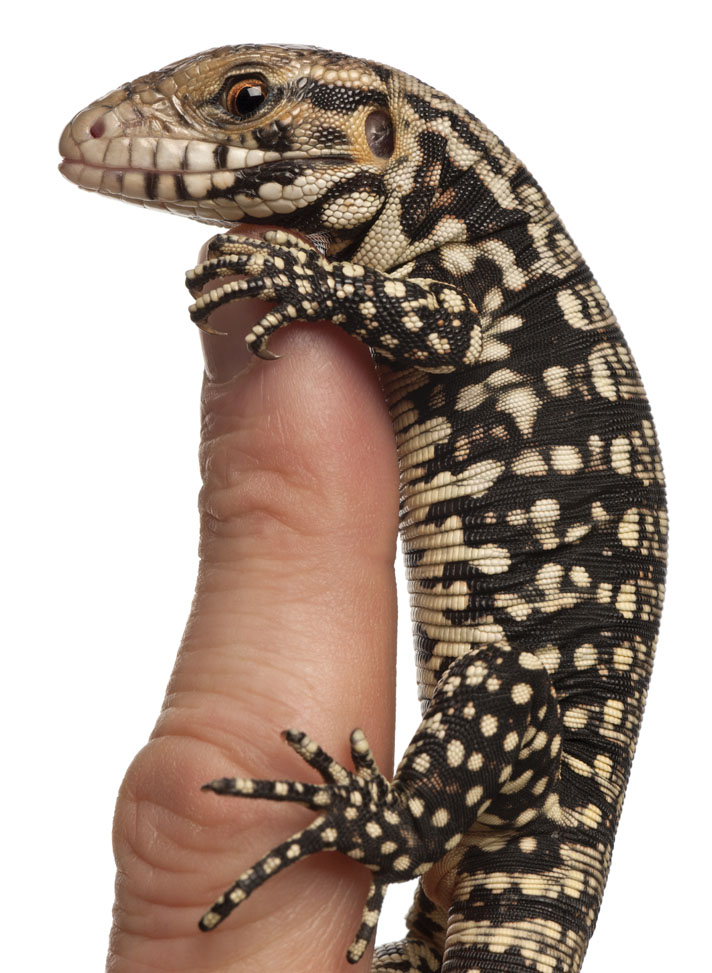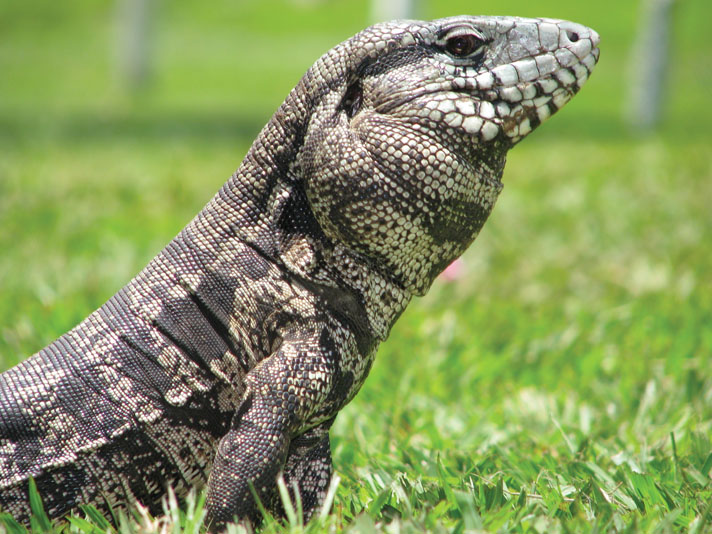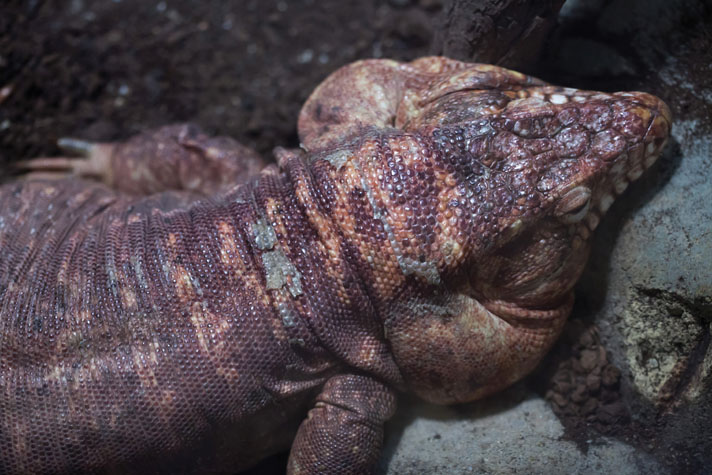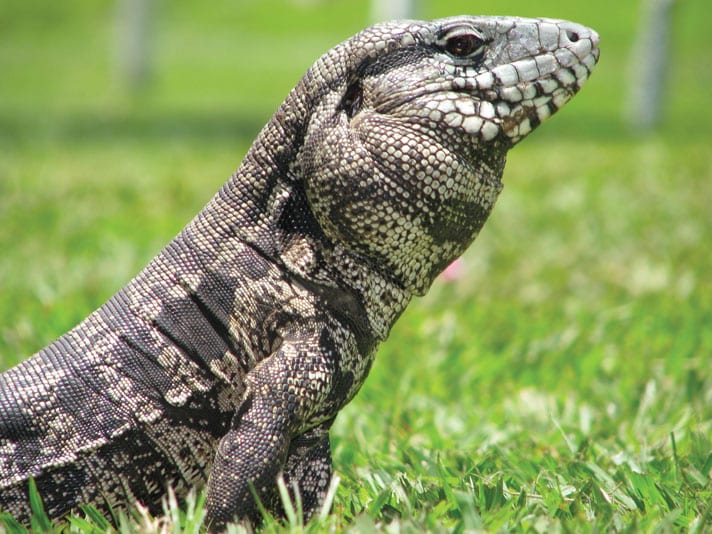Give tegus plenty of space and proper care, and prepare to be richly rewarded.
Have you ever thought about owning a large lizard but weren’t convinced that it would be a good fit for you? Granted, large lizards can also be a bit intimidating to some hobbyists. But if so, I have great news! Tegus have experienced a rise in popularity because they become puppy-dog tame, form strong bonds with their keepers, and they adapt easily to life in captivity. Some have even been taught to come when called by name! Males may have a more menacing appearance due to the development of their large jowls, but they also may feature more intense coloration than females, which have a more “streamlined” appearance.
As regular REPTILES readers know, it’s crucial to educate yourself about the captive needs of any animal prior to acquiring one as a pet. With this article I hope to help you decide if a tegu is a good match for you by providing some specifics regarding the care of these awesome lizards, as well as some brief descriptions of the different types that are (and are not) available.
Housing a Tegu
Hatchling tegus average about 7 to 10 inches in length, so a 40-gallon breeder tank or reptile enclosure measuring 36 by 18 by 17 inches would be OK for one for a little while. Keep in mind that with the proper care described in this article, a young tegus will grow fast, up to an inch a month. For this reason, plan to eventually provide an enclosure that’s at least 6 by 3 by 3 feet. An enclosure of this size would be suitable for an adult tegu for its entire life, but that said, an even larger one measuring 8 by 4 by 3 feet would be preferred.

johnny larocca
Proper handling is recommended in order to tame tegus, and starting when they’re hatchlings will make the taming process much easier.
For substrate, I recommend cypress mulch, coconut coir, or a sand and soil mixture. Tegus require about 75 to 90-percent humidity, and these substrates are the best at retaining moisture in order to provide humidity. Mist the substrate as needed to maintain the recommended humidity level in their enclosure, but also be careful that you aren’t keeping your tegu on an overly saturated substrate. A secure screen top and/or vents should be provided to help with airflow, but be sure you’re not providing too much of this, either, to the point that it becomes impossible to maintain the proper humidity. You may have to experiment a little to get things just right.
A substrate depth of about 4 inches is fine for a hatchling tegu; 8 inches or deeper would be needed for an adult, which has a tendency to burrow into the substrate to rest. As with most pet reptiles, do not use any substrates, such as pine or cedar, that are overly dusty or resinous. These are toxic to tegus!
Want To Learn More?
Build The Perfect Indoor Tegu Enclosure
Golden Tegu Now Four Distinct Species
If your tegu’s enclosure is located indoors, then UVB lighting is mandatory; this is vital to a tegu’s health. There are many great bulbs on the market — look for them in stores that sell reptile supplies — so there is no reason to not equip your tegu’s enclosure with this important feature. Some keepers utilize a 12-hours-on, 12-hours-off light cycle with their tegus, but I use a split cycle that has the lights on for four hours in the morning, then they’re off for four hours before coming back on for four hours in the evening. Then it’s bedtime!
Proper enclosure temperatures for tegus should feature a heat gradient, with a heat lamp positioned over a basking area at the warmer end and a cooler end opposite. The temp at the basking spot should be 100 to 110 degrees Fahrenheit; the warmer end closest to the basking spot should stay around 90 to 95 degrees, and the cooler end of the enclosure should be 75 to 80 degrees.
Handling Your Tegu
I believe it is best, when trying to tame your tegu, that you do not stare directly into its eyes or make sudden moves with your hands. Always be gentle, calm, and talk softly so as not to frighten your pet.
One good method of taming is to take your tegu into a small room, such as the bathroom, and just sit with your pet while letting it roam. It won’t be long before your tegu starts crawling onto you as it gets calmer and perceives no threat from you. Do this regular to promote bonding.
Eventually, as your tegu get older and larger, you will likely be able to place a leash on your pet to take it for a walks!
Food and Water for Tegus
Tegus are omnivores in the wild, so there are many foods you can offer pets. Hatchlings will devour insects, but these must be dusted with calcium powder. Calcium is a must for healthy tegus, both young and adult! Adults can be offered whole frozen/thawed rodents, lean meat, fish, eggs, fruit and vegetation. It is best to vary a tegu’s diet, even if it means having to mix some things together in order to hide vegetation, which some may refuse to eat at first. I do not recommend feeding a whole-prey diet exclusively.
All the tegus discussed later in this article generally have the same feeding requirements. I am partial to offering mine ground turkey, because it’s a lean meat, with added calcium. I feed hatchlings once a day, yearlings every other day, and adults every three days. On in-between days you can offer a treat, such as fresh fruit. Just remember, though, that an overweight tegu will not be a healthy one!
Fresh, de-chlorinated drinking water should be provided daily in a water dish. A larger water container big enough for your tegu to soak in if desired can be provided, and I recommend soaking tegus in lukewarm water twice a week to aid in shedding.
Be sure your tegu can easily enter and exit the larger, possibly deeper soaking container, and I don’t recommend you leave your tegu alone during “bath time.” Although tegus can hold their breath for long periods, I have heard of some that drowned while their keepers were not present to keep an eye on them.
The Types Of Tegus
There have been a lot of exciting changes occurring with tegus, so let’s take a look at the different types of this remarkable reptile! Please note that the classifications below reflect a proposed change that occurred in 2012, when a number of tegus were reclassified from Tupinambis to Salvator, the genus name used for them previously.
Argentine black and white tegu (Salvator merianae).

fabio maffei/shutterstock
The Argentine black and white tegu was first introduced to the U.S. in 1989 by well-known reptile breeder (and frequent REPTILES author) Bert Langerwerf.
This tegu was first introduced in the U.S. in 1989, when the late, great Bert Langerwerf brought some back from Argentina that he successfully bred in a captive environment. Originally found in Central and South America, individuals have bead-like skin and black and white patterning throughout the entire body. Their life span in captivity seems to be 15 to 20 years They grow up to about 5 feet in total length and can weigh as much as 35 pounds. They often become very docile when kept in a stable setting and with the attention needed. These large lizards actually appear to seek human attention and thrive more when kept in a caring environment. Once they learn to trust you, then you will have a close companion for many years!
This species includes a type called the Chacoan tegu, believed to exhibit a greater amount of white coloration on the body and face, and with a tendency to grow a little larger. Salvator merianae also includes a blue form, which has gained popularity in recent years, and I suspect it may receive species-specific classification eventually. Argentine “blues” are reportedly a bit smaller than other types of S. merianae, even though some have been known to reach 4 to 5 feet. They can be differentiated from the other types by their black noses and the black teardrops below both eyes.
Blues are said to inhabit Brazil, Colombia, La Pampa and the French Guiana, and the first ones, six in total, came to the U.S. in a shipment from Colombia. A breeder noticed the difference in their coloration and skin texture and bred them selectively. Today, interestingly, increasing numbers of albinos are being produced from blues.
Argentine red tegu (Salvator rufescens).

Vladimir Wrangel/shutterstock
Adult male tegus are known for being very jowly.
As hatchlings, red tegus display very little red coloration, but it intensifies as the lizards mature. The males are solid, deep red, while the females are more of a patterned dull red. These tegus, too, reach lengths between 4 and 5 feet. They are from the western parts of Argentina, as well as Paraguay. The Paraguayan reds exhibit some white patterns mixed with the red. The males also tend to become stockier than other tegu species, as well as their female counterparts. The Argentine red tegu has also gained popularity due to its beautiful coloration, and some are even called “blood reds” because the red color they exhibit is so intense.
Yellow tegu (Salvator duseni).
The yellow tegu is from Brazil and has never been imported into the U.S. It is very rare, and Brazil will not allow any exports. It is a beautiful species with a strong yellow/gold coloration and black in the face and head area. As of this writing, the only yellow tegus I know of in captivity are those kept at tegu farms and zoos in Brazil. Let’s keep our fingers crossed that we get to see some of these beautiful lizards in the U.S. some day!
Colombian black and white tegu (Tupinambis teguixin).
This tegu comes from a much warmer climate than the Argentine black and white. Though it exhibits a very similar black-and-white coloration, it is smaller, growing to 3½ to 4 feet in length, and its skin has a smoother texture that is not as pebbly as the Argentine species. The most noticeable difference between the two black and white species is the Colombian’s one loreal scale as compared to the two on all Argentine tegus (loreal scales are the scales between the nostril and the eye). Many Colombian tegus will not become as tame as the Argentine species, but this may depend on the keeper. As with any other animal, build trust first and be patient. I owned a Colombian tegu that would take naps with me on the couch! One thing I noticed is that they can be one-owner pets, and once a Colombian tegu learns to trust you it will normally be only you it will trust unless you allow others to handle them and build that trust. This tegu is not being bred in captivity in the U.S. that I know, and because of that, less-expensive wild-caught animals are what’s available in the pet trade.
Tupinambis teguixin includes a gold variant, known as the gold tegu, from northern and central South America, as well as Panama. I definitely recommend obtaining one as a hatchling only, as a full-grown, wild yellow tegu is extremely tough to tame! Gold tegus are known to be very aggressive, but many people have raised and kept them as pets with no problems. Their golden coloration is gorgeous. As with the Colombian black and white tegu, wild-caught golden tegus are readily available in the pet trade because no captive breeding is taking place in the U.S.
The breeding of blue tegus seems to be producing more albinos. Some have red eyes and some have brown eyes. I personally think the brown-eyed specimens may have the stronger genes, as the red-eyed ones are extremely sensitive to light, and some have been born blind. But albino tegus, in my opinion, are the most beautiful of the tegus. Perhaps concerns regarding their overall health can be alleviated if in the future only strong and healthy albinos are bred together through selective breeding. Look for these fascinating creatures to become increasingly available in the pet market as demand for them grows.
Tegus are not as commonly kept as other lizard species, due to several factors, such as size and availability. Let’s face it, visit any reptile expo and you’re never going to find as many tegus are you will bearded dragons or leopard geckos. And while it’s true that these majestic creatures do require some special considerations in order to be kept properly, I believe those who do endeavor to keep them will find themselves richly rewarded.
If you’re looking for a large, impressive lizard to keep as a pet, and one that is fairly mellow in most cases (there are always exceptions, of course, including the previously mentioned golden tegu), then I highly recommend you consider a tegu. Of the types discussed here, one is bound to be the perfect pet for the right person!
Johnny LaRocca is a long-time tegu breeder based in Georgia. Visit his website at teguterra.com.



